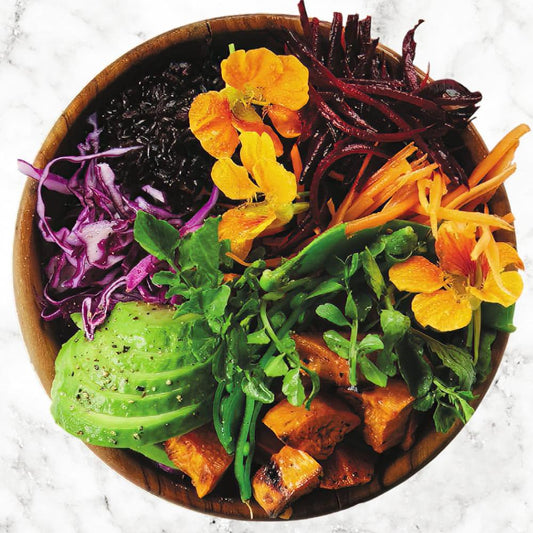Arugula is a loose, basal rosette of strongly lobed, flat leaves attached to fibrous stems. The leaves are normally gathered in tiny sizes, ranging from 7 to 10 centimeters in length, and are smooth and bright green with pronounced veining and frilled margins. The leaves are also linked to a white to pale green, fibrous stem, which adds to the crisp, succulent, and slightly chewy texture of the leaves. Young arugula has a gentler, sweeter flavor and a sensitive texture. Mature leaves produce a unique peppery, slightly bitter, and vegetal flavor with faint mustard, almonds, and grass flavors.

Arugula, botanically known as Eruca sativa, is an ancient green that grows 20 to 70 cm tall and belongs to the Brassicaceae, or mustard family. The herbaceous annual with deeply lobed leaves are native to the Mediterranean, where it has been utilized in medicinal and culinary uses for thousands of years. In Europe, arugula is also called Rucola, Rocket, Roquette, and Ruchetta, and there are other types commonly branded as Arugula, each with a slightly different appearance and flavor. Arugula is now popular globally as a peppery salad green, particularly in Europe and North America, and has also become a widespread leaf used as a herb and vegetable in many culinary uses.
Arugula’s History
Arugula is thought to have grown wild in temperate areas of the Mediterranean in southern Europe since ancient times. The first written record of the plant is from the 1st century CE. Spicy greens were used a lot in the Egyptian and Roman empires. Once upon a time, people thought that arugula was an aphrodisiac. It was used with lavender as a love potion to wake up the mind and body.

Later, in the early Middle Ages, the greens grew wild in parts of Northern and Western Europe and became a common salad green in both the kitchens of the wealthy and those of regular people. Arugula was eventually brought to the New World by European immigrants. Over time, the greens have gone through times when they were very popular and times when people didn't like them. In the 1990s, American chefs and consumers loved them again. Today, arugula is grown all over the world by commercial growers and in home gardens because it is resistant to pests. You can also buy nutty greens at farmer's markets, specialty stores, and supermarkets.
Arugula’s Nutritional Value
Arugula is high in vitamin A, which helps to maintain healthy organ function, and vitamin C, which helps to strengthen the immune system while lowering inflammation. The peppery greens also contain calcium, which helps to protect bones and teeth, as well as lesser levels of folate, iron, vitamin K, copper, zinc, and magnesium.

Arugula includes glucosinolates, which are chemicals with detoxifying effects and give the leaves their pungent, slightly bitter smell, in addition to vitamins and minerals.
According to the USDA National Nutrient Database, around 40 grams (2cups) of arugula contains:
- 10 calories
- 3 grams of fat
- 1 gram protein,
- 5 grams of carbohydrate (including 0.8 grams of sugar and 0.6 grams of fiber)
- 20% Vitamin A
- 50% Vitamin K
- 8 % Vitamin C
- 8% calcium
- 8% folate of the recommended daily values
The Aggregate Nutrient Density Index (ANDI) ranks arugula as one of the top 20 foods in terms of how many phytonutrients, vitamins, and minerals it has to how many calories it has.

For a food to get a high rank, it needs to have a lot of nutrients and very few calories.
Arugula has a flavor that is both nutty and spicy, making it an excellent choice for applications that require only a light amount of cooking, such as sautéing, blanching, and stir-frying. The greens can be utilized fresh, added at the end of cooked applications, or minimally cooked to provide a more subdued flavor. Moreover, they can be used as either a vegetable or herb. You may use the leaves in a variety of different ways in the kitchen, such as tossing them fresh into salads, blending them into pesto, layering them in sandwiches and burgers, or using them as an edible bed for roasted meats.

You can also use arugula as a substitute for spinach in omelets, float it on top of soups and stews, use it as a topping for pizza, toss it into pasta and rice dishes, serve it with cooked potatoes, and so on. Arugula is delicious when combined with berries, melons, pears, citrus fruits, olives, tomatoes, broccolini, nuts like walnuts, almonds, and pine, meats like beef, fowl, and turkey, shellfish, and anchovies. The deeply lobed leaves can be preserved for three to ten days if they are wrapped in a paper towel, placed in a plastic bag, and placed in the crisper drawer of the refrigerator.
Arugula Has Numerous Health Benefits
Arugula is loaded with antioxidants, which are substances that can either prevent or reverse the harm that is done to your cells.

Arugula also has glucosinolates. These naturally occurring compounds, which are responsible for arugula's astringent flavor and pungent aroma, have been hypothesized to offer protection against a variety of malignancies, including breast, prostate, lung, and colon cancer. Moreover, arugula has anti-inflammatory properties. Vitamin K, which is present in high quantities in this food, is beneficial to bone health and may have a role in the prevention of osteoporosis.
Arugula Helps Control Blood Sugar
Because it is a vegetable that is low in calories, arugula is a wonderful choice for people who are trying to lose weight. A serving size of 100 grams only contains about 25 calories in it. Arugula's low carbohydrate content and high fiber content are two of its most important health benefits, both of which support successful weight loss efforts. In addition, eating this vegetable can help you meet many of your daily nutrient requirements without adding an unneeded burden of calories to your diet. As a result, you don't have to be concerned about putting on extra weight if you consume arugula.
Arugula Helps Reduce Cancer Risk
Cruciferous vegetables, such as arugula, include a class of anti-cancer substances called glucosinolates, which are molecules that contain sulfur. These compounds are found in cruciferous vegetables.
According to the National Cancer Institute, the process of cooking and eating food causes glucosinolates to degrade into biologically active molecules. These compounds have been associated with the prevention of the development of cancer.
According to an article that was published in the journal (BBA) Reviews on Cancer in December 2014, epidemiological evidence has linked the consumption of a greater quantity of cruciferous vegetables with a reduced incidence of cancer.
According to research published in the issue of PLOS One that was published in June 2014, arugula possesses large quantities of erucin, which may be responsible for a variety of anticancer activities.
In addition, arugula is rich in antioxidants, which are substances that help prevent oxidative damage from occurring to our cells. According to the USDA Agricultural Research Agency, several studies have found a correlation between consuming two to three servings of dark leafy greens such as arugula weekly and a reduced chance of developing breast cancer, skin cancer, and stomach cancer.
Arugula Helps Prevent Osteoporosis
Calcium and vitamin K are two of the most important elements for maintaining bone health, and arugula is rich in both of these nutrients.
According to the Office of Nutritional Statistics (a reliable source), vitamin K plays an important role in the metabolism of bones, and a lack of vitamin K can lead to an increased risk of bone fractures. One of the most important dietary sources of vitamin K is found in dark, leafy green vegetables.
The Food and Drug Administration (FDA) recommends that individuals consume 80 micrograms (mcg) of vitamin K daily, and one cup of arugula contains 21.8 micrograms (mcg) of vitamin K. Verified Source.

Consuming an adequate amount of vitamin K helps to promote bone health by performing a critical function in the process of bone mineralization. Vitamin K also contributes to an improvement in the manner in which the body absorbs and excretes calcium, another vital nutrient for bone health.
A cup of arugula contains 32 milligrams (mg) of calcium, which counts toward an adult's daily need of 1,000 mg of calcium. Moreover, arugula helps a person meet their daily need for vitamin K, which is provided by a cup of arugula.
Arugula Helps Improve Heart Health
Consumption of vegetables, particularly cruciferous vegetables, has been shown to have a protective effect on the heart.
According to the findings of a meta-analysis conducted in 2017, diets that are high in cruciferous vegetables, salads, and green leafy vegetables are associated with lower rates of the development of cardiovascular disease.

In addition, a study that was conducted in 2018 and published in the Journal of the American Heart Association found that older women who had a diet that was high in cruciferous vegetables had a lower risk of developing atherosclerosis. Plaque buildup in the arteries is a frequent ailment known as atherosclerosis, which raises the likelihood that a person will experience difficulties with their cardiovascular system.
The fact that these veggies have such a high concentration of beneficial plant components, such as polyphenols and organosulfur compounds, could be the reason why they have a protective effect on the heart.
How to Buy, Prepare & Store Arugula
Although arugula is typically available all year long, the months of late July through December are when it has the most robust flavor. The usual rule of thumb is that older, darker green leaves and thicker stems have a more peppery flavor, but they also tend to have a more bitter aftertaste than younger, lighter green leaves. If you want to get the most out of the experience of eating the whole, nutritious stem, it is better to buy arugula that was grown locally or organically. Always be on the lookout for crisp leaves, as withered leaves and dark patches are signs that the product is not as fresh as it ought to be.
How to Store Arugula
Put your arugula in the crisper drawer of your refrigerator for optimal freshness. It can be stored for up to three days if it is wrapped or placed in a container. The best way to ensure that loose leaves keep their moisture is to wrap them in paper towels that have been dampened. You can also get the leaves back to their crisp state by soaking them in ice water for a few minutes before you serve them. If the leaves have become wilted, it is better to exclude them from salads; however, as long as they have a pleasant aroma and have not become mushy, you may use them in warm meals such as pasta.

How to Clean & Cut Arugula
Usually, arugula is offered ready to cook and often only needs to be washed. Arugula from the market sometimes comes as a whole bunch. Here you should cut off the individual leaves about 2 - 3 cm. below the base of the leaves on the stem. Thick or long stems can be shortened, because they contain the most nitrates and most of the - but very healthy - bitter substances.



